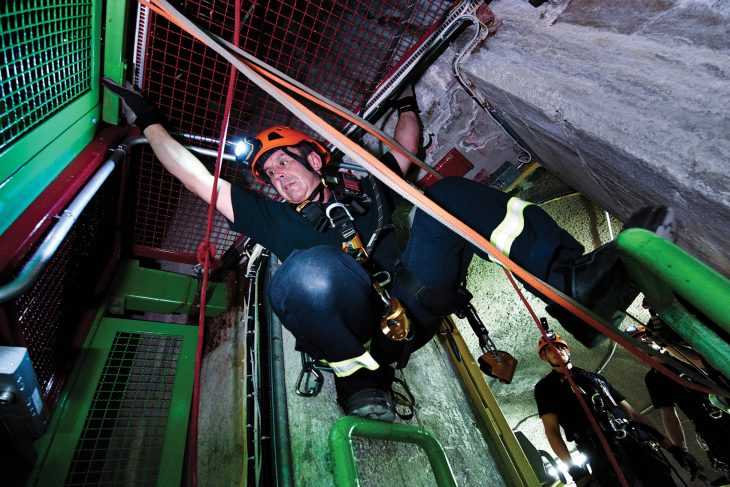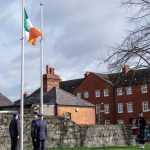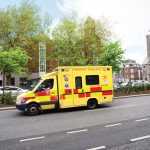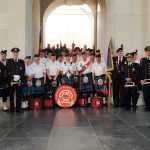Working with the fire service at the international organisation seeking to discover what the universe is made of is a unique and exciting experience, Operational Leader Stephen Gunning tells Adam Hyland.
Scientists from all over the world continue to search for answers to the big questions relating to the fundamental physics of our universe using CERN’s unique range of particle accelerator facilities, but while they push the frontiers of science and technology, their work with the Large Hadron Collider (LHC) and other unique pieces of equipment couldn’t be done safely without the presence of CERN Fire and Rescue Service.
While most people know about CERN (the European Organisation for Nuclear Research), the LHC and the study of the particles that make up matter, few of us would think about the work being done above and below ground by what is probably the most unique fire service in the world.
Operational Leader Stephen Gunning, who had served for 30 years as a firefighter and senior manager in Scotland, was only too happy to find out about them. “I was leaving the Scottish Fire Service and looking to see what different opportunities were there,” he tells me. “I knew about CERN because I am interested in physics, and I saw that they were looking for officers, so I applied. They needed someone with my skills (in-depth experience in people and asset management, and fore and accident investigation and analysis) and the two things aligned. The opportunity to come and work here was fantastic, to get to learn about physics and see how experiments are produced in such a large international organisation.”
DIVERSITY
CERN’s workforce of over 2,500 staff members and approximately 14,000 users is hugely diverse, and the fire service mirrors this, with ten different nationalities forming the Group. While some fire services around Europe offer secondment, other firefighters, like Stephen, come because of the chance to work in such a unique environment. Contracts are on a five-year basis, with the option to extend that for another three years, and as Stephen says, “our set-up does present a few differences when you come from another fire service”.
He continues: “We don’t have ranks similar to the UK, for example, but we do fit into a similar structure. We have a non-uniformed manager who oversees our group from an organisation perspective, including how CERN operates, and we provide the strategic overview of how to operate the fire service. As one of three Operational Leaders, I am akin to a Senior Officer, then we have Officers, Watch Managers, Firefighters. Because there are only 48 firefighters forming four teams, they do need to change, and this is why we bring people in from different fire services, so we can interchange them based on what we need.”
SPECIALISTS
There are three specialities within the team, Stephen tells me: The technical firefighters with core skills in radiation, chemicals and rope rescue, the safety control room firefighters whose skills are vital as they need to make a lot of immediate critical decisions based on the information they receive, and the ambulance crews, trained to technician level.
“CERN provides different levels of integration and brings people with different levels of experience into the organisation, with huge links to universities because of the mission of pushing international learning and research,” he tells me, “but when it comes to the fire service, you obviously can’t take people in who have no experience. You need to have a minimum of five years’ experience in a fire service, so you must already have the core skills. What you do develop are the specialist skills you need to work here. You bring your set of skills and use them in a completely new environment.”
That new environment includes over 50km of tunnels up to 140metres below ground, and requires unique pieces of equipment and strategic planning. As well as having two fire appliances and ambulances, the crews rely on specialised trolleys that can bring them deep into the tunnels quickly. “A lot of our equipment is stored on trolleys so we can take what we need at any given time,” Stephen tells me, “because we can’t carry all of the equipment at once – it won’t fit. We also strategically locate equipment around the laboratory complex, such as at the LHC area, but the specially-designed trolleys that transport us through the tunnels are a unique aspect to a unique environment. Firefighters who come here will
have never seen anything like this, unless they have worked in a specialist tunnel environment.”
He continues: “To be able to go into the experiment halls and caverns and to see what is being done, and thinking about how you would handle potential fires in these areas, that is unique.
“We also have quite a large area above ground, with lots of standard buildings, but we also have areas that have specialist equipment and radiation requirements. But the dominant risk is underground. You have to think about how you would handle an incident in a tunnel – and we have more than 50km of tunnels in a huge network – you go down a shaft, gain access to a tunnel, and travel along several kilometres underground just to get to a potential fire.”
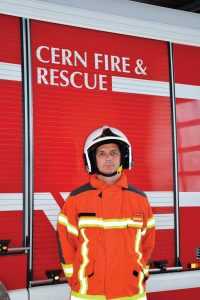
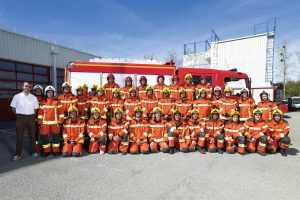
DUTIES
The main call outs for the teams involve responding to fire alarms around the vast complex, which have to be investigated, and medical incidents, and not surprisingly given the enormous amount of energy being used, electrical fires. CERN has its own electrical network and receives 400,000 volts which is reduced and distributed to all of its sites, meaning “there is high voltage all over” as Stephen points out. The levels of radiation used, and the fact that CERN is probably the biggest cryogenics plant in the world and uses the most helium of any organisation (in order to cool the magnets in the accelerators to -271.3C), mean that the crews really need to be aware of the potential dangers.
“Generally, and thankfully, we don’t have a lot of large fires here,” Stephen says. “Any fires or safety hazards are identified quickly because of the number of technicians and controls in the experiments. This is because of the way in which the technology is running, the experiments have so much remote monitoring, so if they get a leak in cryogenics, or an electrical fault, they know immediately, because of the in-built safety systems necessary for conducting experiments on such a large scale. There is a very high level of perfection. There needs to be.”
As a result, understanding those risks and the topography of the area are crucial. “It’s really important for us to understand where the risks are in a place like this,” Stephen says. “You need to understand the physics of what is happening here, and know what to do if there is an incident, because the risks associated with the technologies are huge, and every firefighter has to have a very in-depth knowledge and appreciation of the circumstances.
“That is why one of the most important things we do on a daily basis is learn and revise the topography, where we are in the tunnel structure. We also do a lot of visitations to the various departments to keep everybody up to speed on fire safety and risk knowledge, because we have to make sure that incidents are prevented, rather than having to be dealt with.”
KNOWLEDGE SHARING
Stephen says there is a positive two-way sharing of knowledge within the organisation. “The physicists here all know the risks, the machines and experiments are so critical to them, so they are maintained to the highest level,” he tells me. “And scientists are generally open to education from us. There is a balance there, where we ask the questions about physics, and then we teach them about the fire safety and prevention necessary to run their experiments, and we come to an agreement on what is required. These experiments have to go ahead, but there has to be safety and an understanding of operational tactics from our end.”
This exchange of information sees the fire service play an integral role in the planning stage of CERN’s experiments. “We are constantly making sure the fire service here is involved from the early stages, and this is one of the key reasons for somebody like myself coming here,” says Stephen.
“You are able to be involved in the design of the building in which these major experiments are taking place, and that is such an exciting thing to be a part of. CERN works with our group to look at how they can incorporate our input into how we can tackle a fire in these new structures. Normally you have building regulations, and that is true for the most part, but there is no code on how to build complex and sometimes unique experimental structures and equipment, such as the LHC. You’ve got the tunnels and the distances between them, so you have to have some realisation of how you are going to tackle a fire. Fire engineering and tactical firefighting are coming together in the development of these new technologies. If we want something done in the design of the shaft, or want extra fire doors put in, there is an understanding of why that is needed.
“Of course, you will see from any photos of the CERN infrastructure that it is extremely difficult to have compartmentalisation, so you are not in an ideal world, because you can’t stop the accelerator, it has to be continuous, but we are looking at how we can improve and perfect fire prevention and fire management. Fire engineering is an emerging field in this respect: Looking at what the potential fire risks are in a building or structure design, and how we can use fire engineering modelling to assist us in developing our intravention plans.”
Being part of something so interesting is definitely one of the best aspects of the job for Stephen. “It is fascinating to me,” he admits. “You go into these experiment halls and see these huge experiments, but you also get to see how these things start, from very small experiments in a lab that just keep building to an enormous scale. It’s something very few firefighters in the world get to see.
“If people have the opportunity to come here, I would recommend they do. If you want to gain experience working with a major international organisation, a unique understanding of tunnels, radiation, cryogenics, this is the place. We don’t have a lot of operational activity, and that is a good thing. But we are here because of the risk of that.”
If a major incident were to occur, the CERN Fire and Rescue Service has a strong working relationship with the neighbouring fire services in France and Switzerland. “Our primary role in an incident is to give an initial assessment and to prevent it turning into anything significant,” Stephen says. “If we do get a large fire, our French and Swiss counterparts will supply whatever is needed, and to facilitate this we train regularly with these host states, both officers and firefighters.
“It takes up to five years to understand the physics and topography, and the structure of CERN, and to ask another fire service to come here and handle an incident would be difficult, it is too different. So, if we have a large incident the roles change, we oversee the strategic approach, providing the knowledge needed to handle the situation. And we all need that knowledge.
“CERN will handle the incident as much as it can, but is always able to call upon host countries for help. But as mentioned, one of the key roles for us is fast intervention, to resolve the incident quickly, control it, before it gets any bigger.”
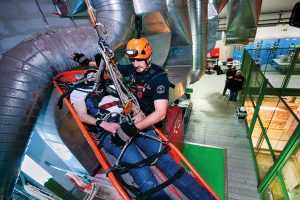
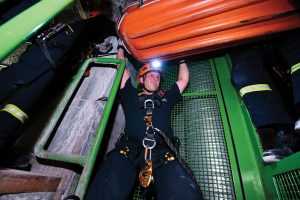
DEVELOPMENT
The dynamic nature of the role is mirrored by the constant rate of development at CERN, and while Stephen has been there for two and a half years, he is still excited by events at the organisation.
“There are new experiments being done all the time,” Stephen says. “As we speak, there is a new tunnel being dug out, so the people here now will see this from the construction phase right up to a new experiment being put in place.
“Not every organisation could have as a requirement that you have to stay for at least five years and still get the level of interest we do, and in the next two years there will be a high level of recruitment. Many firefighters choose to bring their families over, because as part of the contract you need to live within the area, but not all do. Some travel back and forth on their time off, but many see it as a chance to have a new experience. They bring their family over, see another culture, put their children into school to learn another language, and get to work in a fascinating environment. It’s a great opportunity.
“Another unique thing about working at CERN is that we sit right on the border, so one minute you are working in France, the next you are in Switzerland, and we are underground within those two countries a lot of the time. Even some of our main buildings are half in France and half in Switzerland, so you cross borders walking across the lobby.”
While the environment may be unique, Stephen is also quick to point out that the job is still very much one of a firefighter. “No matter where you come from, firefighters essentially all do the same thing. Some countries emphasise different aspects of the job, but that is part of the uniqueness of CERN – you get to learn from other firefighters around Europe, and that is just another interesting aspect of working here.”

